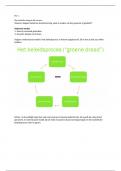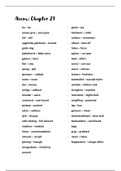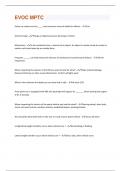Chapters: 1, 4, 5, 6, 7, 8, 10, 12, 15, 16, 18, 19, 20, 22, 24, 25 and 26
Lecture 1 – Introduction (chapter 1)
Lecture outline
• What is corporate finance? The role of the financial manager
• Financial markets
• Financial statement analysis
What is corporate finance? The role of the financial manager
Financial markets
Financial markets – capital markets
• Primary market
- When a corporation issues securities (stocks or bonds), cash flows from investors to the firm
• Secondary market
- Involve the exchange of already issued securities between investors
- Securities may be exchange traded or traded over-the-counter in a dealer market
1
,Financial statement analysis
• Liquidity ratios
• Solvency and leverage ratios
• Asset management/turnover ratios
• Profitability ratios
• Market value ratios
Financial statements provide important information about the economic situation of the firm, but:
• Financial statements do not express the risk
• Financial ratios generally refer to performance in previous years
Financial statement analysis – networking capital
Balance sheets company A
2
,Financial statement analysis – liquidity
= Ability to pay back short-term debts in time
• Net working capital = current assets – current liabilities
- If positive, then available cash is larger than cash to be paid in next 12 months
- Example:
Liquidity ratios
= Ability to pay all bills in the short run
𝑐𝑢𝑟𝑟𝑒𝑛𝑡 𝑎𝑠𝑠𝑒𝑡𝑠
• Current ratio = 𝑐𝑢𝑟𝑟𝑒𝑛𝑡 𝑙𝑖𝑎𝑏𝑖𝑙𝑖𝑡𝑖𝑒𝑠
- Current ratio = = 1.84
𝑐𝑢𝑟𝑟𝑒𝑛𝑡 𝑎𝑠𝑠𝑒𝑡𝑠−𝑖𝑛𝑣𝑒𝑛𝑡𝑜𝑟𝑖𝑒𝑠
• Quick ratio = 𝑐𝑢𝑟𝑟𝑒𝑛𝑡 𝑙𝑖𝑎𝑏𝑖𝑙𝑖𝑡𝑖𝑒𝑠
- Inventories are less liquid (also called: acid test ratio)
- Quick ratio = = 0.99
Solvency ratios
= Ability to pay all debts when firm stops to exist
𝑇𝑜𝑡𝑎𝑙 𝑎𝑠𝑠𝑒𝑡𝑠
• Equity multiplier = ( = 1.99)
𝐸𝑞𝑢𝑖𝑡𝑦
𝐿𝑖𝑎𝑏𝑖𝑙𝑖𝑡𝑖𝑒𝑠
• Debt equity ratio = ( = 098)
𝐸𝑞𝑢𝑖𝑡𝑦
𝐿𝑖𝑎𝑏𝑖𝑙𝑖𝑡𝑖𝑒𝑠
• Debt ratio = 𝑇𝑜𝑡𝑎𝑙 𝑎𝑠𝑠𝑒𝑡𝑠 ( = 0.49)
𝐸𝐵𝐼𝑇
• Times interest earned ratio = ( = 9.91)
𝑖𝑛𝑡𝑒𝑟𝑒𝑠𝑡 𝑝𝑎𝑦𝑎𝑏𝑙𝑒
Asset management or turnover ratios
= Ability to use the assets effectively and efficiently
𝑆𝑎𝑙𝑒𝑠
• Asset turnover ratio = 𝑇𝑜𝑡𝑎𝑙 𝑎𝑠𝑠𝑒𝑡𝑠 ( = 2.47)
(Sales per unit of asset)
𝐶𝑜𝑠𝑡 𝑜𝑓 𝑠𝑎𝑙𝑒𝑠
• Inventory turnover = 𝐴𝑣𝑒𝑟𝑎𝑔𝑒 𝑖𝑛𝑣𝑒𝑛𝑡𝑜𝑟𝑖𝑒𝑠 ( = 11.38)
(Number of times a year the average inventory is sold)
365
• Days in inventory = 𝐼𝑛𝑣𝑒𝑛𝑡𝑜𝑟𝑦 𝑡𝑢𝑟𝑛𝑜𝑣𝑒𝑟 (.38 = 32.05 days)
(Number of days it takes to sell an average inventory)
Financial statement analysis – ratio analysis
• How do grocery stores operate?
3
,Profitability ratios
𝑁𝑒𝑡 𝑖𝑛𝑐𝑜𝑚𝑒
• Return on assets = 𝑇𝑜𝑡𝑎𝑙 𝑎𝑠𝑠𝑒𝑡𝑠 ( = 13.55%)
(Note: ROA is also sometimes defined as EBIT / Total Assets)
𝑁𝑒𝑡 𝑖𝑛𝑐𝑜𝑚𝑒
• Return on equity = 𝐸𝑞𝑢𝑖𝑡𝑦
( = 26.8%)
𝑁𝑒𝑡 𝑖𝑛𝑐𝑜𝑚𝑒
• (net) Porfit margin = 𝑆𝑎𝑙𝑒𝑠
( = 5.5%)
Market value ratios
𝑁𝑒𝑡 𝑖𝑛𝑐𝑜𝑚𝑒
• Earnings per share = ( = 0.294)
𝑁𝑢𝑚𝑏𝑒𝑟 𝑜𝑓 𝑠ℎ𝑎𝑟𝑒𝑠
𝑀𝑎𝑟𝑘𝑒𝑡 𝑣𝑎𝑙𝑢𝑒 𝑝𝑒𝑟 𝑠ℎ𝑎𝑟𝑒
• Market to Book ratio = (2.50 / (1097/1000) = 2.28)
𝐵𝑜𝑜𝑘 𝑣𝑎𝑙𝑢𝑒 𝑝𝑒𝑟 𝑠ℎ𝑎𝑟𝑒
𝑃𝑟𝑖𝑐𝑒 𝑝𝑒𝑟 𝑠ℎ𝑎𝑟𝑒
• Price earnings ratio = 𝐸𝑎𝑟𝑛𝑖𝑛𝑔𝑠 𝑝𝑒𝑟 𝑠ℎ𝑎𝑟𝑒 (2..294 = 8.5)
Financial statement analysis – The Du Pont identity
𝑁𝑒𝑡 𝑖𝑛𝑐𝑜𝑚𝑒 𝑁𝑒𝑡 𝑖𝑛𝑐𝑜𝑚𝑒 𝐴𝑠𝑠𝑒𝑡𝑠
• Return on equity = 𝑇𝑜𝑡𝑎𝑙 𝑒𝑞𝑢𝑖𝑡𝑦 = 𝐴𝑠𝑠𝑒𝑡𝑠 × 𝑇𝑜𝑡𝑎𝑙 𝑒𝑞𝑢𝑖𝑡𝑦
𝑆𝑎𝑙𝑒𝑠 𝑁𝑒𝑡 𝑖𝑛𝑐𝑜𝑚𝑒 𝐴𝑠𝑠𝑒𝑡𝑠
• ROE = 𝑆𝑎𝑙𝑒𝑠 × 𝐴𝑠𝑠𝑒𝑡𝑠
× 𝑇𝑜𝑡𝑎𝑙 𝑒𝑞𝑢𝑖𝑡𝑦
𝑁𝑒𝑡 𝑖𝑛𝑐𝑜𝑚𝑒 𝑆𝑎𝑙𝑒𝑠 𝐴𝑠𝑠𝑒𝑡𝑠
• ROE = 𝑆𝑎𝑙𝑒𝑠
× 𝐴𝑠𝑠𝑒𝑡𝑠 × 𝑇𝑜𝑡𝑎𝑙 𝑒𝑞𝑢𝑖𝑡𝑦
(Return on assets)
= profit margin × total asset turnover × equity multiplier
0.27 = 0.055 × 2.47 × 1.99
Very main points of this lecture
• What is the economic condition of the firm?
• Balance sheet, profit loss account and cash flow statement
• Financial statements
- Liquidity
- Solvency
- Asset management and turnover
- Profitability
- Market value
Lecture 2 – Chapter 4 & 5
Lecture outline
• One-period case (4.1)
• Multiple-period case (4.2)
• Compounding periods (4.3)
• Simplifications (4.4)
• Applications:
- Bound valuation (5.1-5.2)
- Equity valuation (5.4)
- Firm valuation (5.9)
4
,One-period case – certainty
• Keith is trying to sell a piece of land. Yesterday (ca. now) he was offered €10,000 cash for the
property. (OPTION 1) He was about ready to accept the offer when another individual offered him
€11,424, to be paid next year. (OPTION 2) Which offer should Keith choose, assuming that both
offers are reliable?
• Future or Compound Value (orange arrow)
- Invest €10,000 at bank savings rate of 12% = €11,200 in one year.
- Compared with €11,424, the second option is better.
• Present or Discount Value (green arrow)
𝐂𝟏
- €11,424 back to today’s value is €10,200. 𝑷𝑽 = 𝟏+𝐫
discount rate
PV = 11..12 = 10.200
- Compared with €10,000 now, the second option is better
One-period case – NPV
• Frequently, we want to calculate the incremental cost or benefit from adopting an investment. This is
the Net Present Value (NPV).
• 𝑵𝑷𝑽 = −𝐂𝐨𝐬𝐭 + 𝐏𝐕
One-period case – uncertainty
• Professional Artworks plc is a firm that speculates in modern
paintings. The manager is thinking of buying an original Picasso for
€400,000 with the intention of selling it at the end of one year. The
bank interest rate is 10 percent.
• The manager expects that the painting will be worth €480,000 in
one year. However, this expected value is uncertain. The manager
chooses a higher discount rate (25 percent) to reflect this risk.
• Should she buy the painting?
€480,000
- Discount cash flows at 10%: 1.10
= €436,364 (NPV = 400,000 + 436,364 = + €36,364)
€480,000
- Discount cash flows at 25%: 1.25
= €384,000 (NPV = 400,000 + 384,000 = - €16,000)
Multiple-period case – FV
• Suppose you deposit €1 for one year at a rate of 9%. How much will it amount to in one year?
- €1 x (1 + r) = €1 x 1.09 = €1.09
• What happens if you leave it in the account for another year?
- €1 x (1 + r) x (1 + r) = €1 x (1 + r)2 = 1 + 2r + r2 = €1.1881
• FV = C0 x (1 + r)T
Suh-Pyng Ku has put €500 in a savings account at Barclays. The account earns 7%, compounded
annually. How much will Ms. Ku have at the end of year three?
- €500 x 1.07 x 1.07 x 1.07 = €500 x (1.07)3 = €612,52
Carl Voigt, who recently won €10,000 in the lottery, wants to buy a car in five years. Carl estimates that
the car will cost €16,105 at that time. What interest rate must he earn to be able to buy the car?
• r = (FV / C0)1/T – 1
- The ratio of purchase price to initial cash is 16,105/10,000=1.6105. Thus, he must earn an interest
rate that allows €1 to become €1.6105 in five years.
- Algebraically: €10,000 x (1 x r)5 = €16,105. Or: (1 + r)5 = 1.6105
- Solving for r, gives the answer: 10%
The power of compounding
• Simple interest
- r = 8.47%
- Invest €1 for 215 years
- Interest = €0,0847
- Value of investment at end of 215 years: €1 + (215 x €0,0847) = €18,21
5
, • Compound interest (=samengestelde rente)
- r = 8.47%. Invest €1 for 215 years. Interest = €0,0847
- Value of investment at end of 215 years:
FV = €1 x (1,0847)215 = €39.045,648
Multiple-period case – NPV
• Using the future value formula on slide 11 (FV = C0 x (1+r)T) we estimated that when r = 9%, €1 can
be turned to €1.1881 in two years.
• On the flip side, we can ask how much money needs to be invested today in order to receive €1 in
two years.
• Algebraically we need to solve for PV (present value factor) in this equation:
- PV x (1.09)2 = €1 or PV = €1 / (1.09)2, so PV= €0.84
• PV = Ct / (1 + r)T
Allan Wolf will receive €10,000 three years from now. Allan can earn 8% on his investments, so the
appropriate discount rate is 8%.
• What is the present value of his future cash flow?
- PV = €10.000 x (,08)3 = €10.000 x .7938 = €7,938
• PV = Ct / (1 + r)T
A customer of Chaffkin GmbH wants to buy a tugboat today. Rather than paying immediately, he will pay
€50,000 in three years. It will cost Chaffkin GmbH €38,610 to build the tugboat immediately.
• At what interest rate would Chaffkin GmbH neither gain nor lose from the sale?
• r = (PV / Ct)-1/T – 1
- The ratio of construction cost (present value) to sale price (future value) is 38,610/50,000=0.7722.
Thus, he must earn an interest rate that allows €1 received in 3 years to have a present value of
€0.7722. Algebraically: €38,610 x (1 + r)3 = €50,000. Or, 1/(1+r)3 = 0.7722.
- Solving for r, gives the answer: 9%
Multiple-period case – cash flow
• Paul Wiggins has won a crossword competition and will receive the following set of cash flows over
the next two years:
- Year 1: €2.000 and Year 2: €5,000
Mr. Wiggins currently earn 6% in his money market account. What is the PV of the cash flows?
- Year 1: €2000 x (1/1.06) = 2000 x .943 = €1887
- Year 2: €5000 x (1/1.06)2 = 5000 x .890 = €4450
- Total value: 1887 + 4450 = €6337
• Dratsel.com, an online broker based in Sweden, has an opportunity to invest in a new high-speed
computer that costs SEK 250,000. The computer will generate cash flows (from cost savings) of SEK
125,000 one year from now, SEK 100,000 two years from now, and SEK 75,000 three years from
now. The computer will be worthless after three years, and no additional cash flows will occur.
Dratsel.com has determined that the appropriate discount rate is 7% for this investment. Should
Dratsel.com make this investment in a new high-speed computer? What is the NPV of the
investment?
- Cash flows x present value factor = present value
Year 0 : - 250.000 x 1 = - 250.000
Year 1 : 125.000 x 0.9346 = 116.825
Year 2 : 100.000 x 0.8734 = 87.340
Year 3 : 75.000 x 0.8163 = 61.226
Total = 15,388
𝐂𝟏 𝐂𝟐 𝐂𝐭
- NPV = - C0 + + +…+ =
𝟏+𝐫 (𝟏+𝐫)^𝟐 (𝟏+𝐫)^𝐓
Compounding periods – stated annual interest rate
• Compounding an investment m times a year provides end-of-year wealth of: C0 ( 1 + r/m )m
- where C0 is the initial investment and r is the stated annual interest rate.
- The stated annual interest rate is the annual interest rate without consideration of compounding.
6









